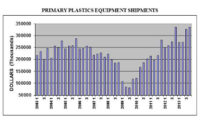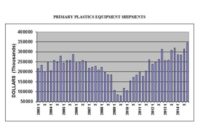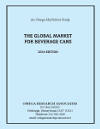Plastics machinery shipments see strong gain in Q2




The accelerating momentum in plastics machinery demand that emerged in the second half of 2013 was sustained through the first half of this year, according to statistics compiled and reported by the Committee on Equipment Statistics (CES) of SPI: The Plastics Industry Trade Association (plasticsindustry.org).
Shipments of primary plastics equipment (injection molding, extrusion, blow molding and thermoforming equipment) for reporting companies totaled an estimated $299.3 million in Q2. This was slightly below the strong total of $300.3 million in Q1 of this year, but it represented a gain of 10% when compared with the total from Q2 of 2013. For the year to date, the total value of primary equipment shipments is 10% ahead of last year.
A closer look at the CES data show that the shipments value of injection molding machinery increased 9% in Q2 of 2014 when compared with the total from Q2 of last year. The shipments value of single-screw extruders slipped 2%, but the value of shipments of twin-screw extruders (which includes both co-rotating and counter-rotating machines) jumped 63%. The shipments value for blow molding machines edged down 2% in Q2.
The CES also compiles data on the auxiliary equipment segment (robotics, temperature control, materials handling, etc.) of the plastics machinery industry. New bookings of auxiliary equipment for reporting companies totaled a record-breaking $108.0 million in Q2. This represented a spike upward of 21% when compared with the total from Q2 of 2013.
This solid gain in the CES data on plastics machinery shipments corresponds with the gains in the two major data series compiled by the U.S. government that measure activity levels in the industrial machinery sector. According to the Bureau of Economic Analysis, business investment in industrial equipment rose by 13% (seasonally-adjusted, annualized rate) in Q2 when compared with Q2 of 2013. The other important machinery market indicator, compiled by the Census Bureau, showed that the total value of shipments of industrial machinery jumped 35% in Q2.
“The manufacturers of plastics machinery that anticipated strong demand and then allocated resources accordingly are being richly rewarded for their efforts in 2014, especially in North America," according to Bill Wood, the plastics market economist who analyzes and reports on the plastics machinery market sector for the CES. "Those companies that hired new workers, increased production capacity, invested in inventories, or all of the above are reaping large returns on those investments this year. As I said before, we are entering the sweet spot of the capital expenditure cycle. It is a good time for plastics manufacturing in the U.S.," says Wood.
The CES also conducts a quarterly survey of plastics machinery suppliers that asks about present market conditions and expectations for the future. The responses from the Q2 survey indicate that a widespread decline in demand is not yet in sight. When asked about expectations for future market conditions, 90% of the respondents expect conditions to stay the same or even improve in the coming quarter, and 88% expect them to hold steady or get better during the next 12 months.
There is a solid consensus that North America is the global region where the strongest gains are expected. Expectations for Latin America and Mexico declined when compared with the responses from last quarter. Expectations for Asia and Europe improved. As for the major end-markets, the respondents to the Q2 survey expect that automotive and medical will remain strong in terms of demand for plastics products and equipment. Expectations for the other major end-markets call for mostly steady conditions in the coming year.
Looking for a reprint of this article?
From high-res PDFs to custom plaques, order your copy today!









